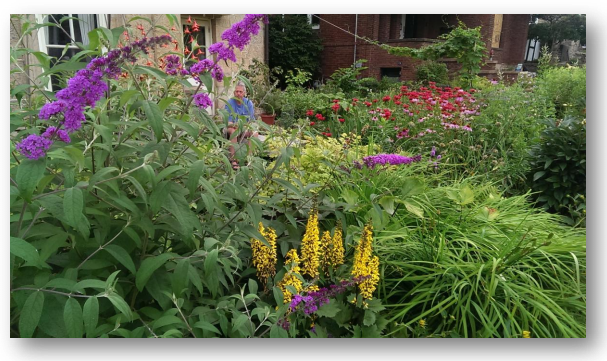Photo: One of many pollinator-friendly yards in the City of Madison, as depicted by the city’s Pollinator Protection Task Force Report. Photo by Ledell Zellers.
By Janette Rosenbaum
During the time that this series was being published, Madison did in fact reform its landscape ordinances. For the first time since 1978, Madison updated its regulations pertaining to “natural lawns”.
Natural lawns – now referred to as “natural landscapes” – are defined by the city as residential yards in which grasses exceed eight inches in height. This category includes yards that are entirely landscaped with prairie plantings, yards that have a single ornamental clump of tall grass, and everything in between.
Previously, all yards in this category were required to obtain a permit. Without a permit, grass in excess of eight inches was a violation of the ordinances. As noted in previous articles in this series, many people in Madison have tall grass in their yard, while few have ever obtained – or even attempted to obtain – a permit.
As described in Part 2 of this series, Madison knew at the time the permit requirement was created that tall grass does not attract rats, hurt property values, or cause any of the other negative impacts commonly attributed to it. Still, the 1976 effort to completely eliminate a ban on tall grass failed due to the concerns of those who continued to believe in tall grass’s bad rap.
Today, Madison recognizes that banning tall grass – and thus virtually requiring fossil-fuel-powered mowing, fertilizers, pesticides, and all the other maintenance practices associated with lawns – interferes with the city’s goal of being more sustainable and more environmentally friendly. Specifically, making it difficult for property owners to establish prairie plantings, by requiring them to go through an onerous permitting process, presents an obstacle to the goal of protecting pollinators, which the city declared to be an urgent priority in the fall of 2015.
Still, the workgroup charged with taking action to protect pollinators failed to fully legalize tall grass. Instead, on January 3, 2017, the City of Madison adopted a limited revision to the natural landscapes ordinances that says the following:
- Grass in residential yards may not exceed eight inches in height.
- Grass in residential yards may exceed eight inches in height, if the property owner obtains a permit.
- Grass in residential yards may exceed eight inches in height without a permit, if the area containing the tall grass only occupies a certain limited percentage of the yard, and if this area is a certain distance from the property lines, and if the tall grass is a species found on a brief list included in the ordinance.
Supporters of the revised ordinance say that this change will make it easier for property owners to legally have natural yards. Others who were hoping for a more progressive update, however, have several concerns about the new rules.
First, the exemption to the permit requirement only helps property owners who have – or who would like to have – small natural plantings. Almost no one in this category currently has a permit, and almost none of them have been prosecuted for not having a permit. Eliminating the permit requirement for small natural plantings helps almost no one, while still leaving property owners with full natural yards vulnerable to prosecution.
Second, enforcement of the new ordinance would require Building Inspection employees to calculate what percentage of a yard is occupied by a natural planting. Although Building Inspection Director George Hank stated, at a city meeting where the proposed revision was being discussed, that his employees were good at math, those employees have stated to the author of this article that they often rely on eyeballing rather than measuring when determining the size and location of plants. If inspectors take that approach to the new ordinance, property owners could be forced to go to court to argue that their planting is in fact smaller than the percentage limit.
In addition, the aspect of the ordinance that allows only certain grass species to bypass the permit requirement depends on inspectors being able to accurately identify grass species. In previous cases, Building Inspection employees have been unfamiliar with native species, and have described natural yards as containing a “significant number of plants [they] couldn’t identify.” Again, a property owner could be falsely accused of not meeting the requirements for the permit exemption, and would then be forced to convince a judge that their grass belongs to the exempted species.
Third, given Building Inspection’s history of enforcing ordinances arbitrarily – as described in previous articles – it is not hard to see how the new ordinance could be misconstrued to mean that even with a permit, a property owner cannot have grass species other than those listed as allowable without a permit. The new section of the ordinance also requires tall grasses to be set back at least five feet from property lines – a requirement that could be inappropriately applied to those who have permits, who currently must provide a setback of only three feet, or none at all with the permission of the adjoining neighbor.
Clearly it is not the intention of the new ordinance to be more restrictive than the old one, but the confusing wording, along with the structure of exemptions to exemptions, could again force property owners to go to court to sort out which requirements apply to the type of yard that they have. The simple solution: stop imposing onerous regulations on grass, and allow property owners to landscape their yards with the most harmless and regionally-appropriate of plants.

